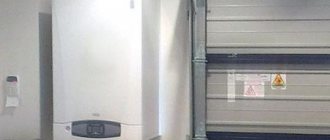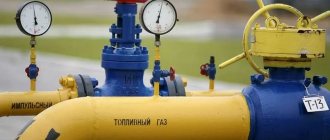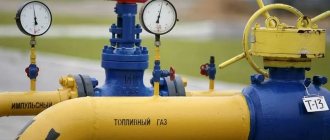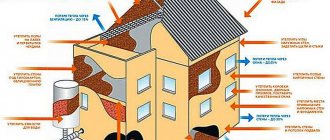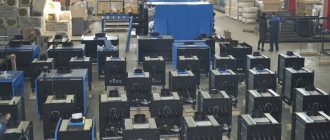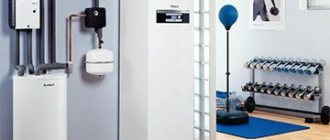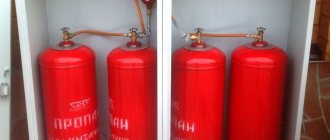When designing a heating system for a home, owners are required to know in advance how much it will cost to heat their living space during operation. Ultimately, it may be that the heating system will simply be unprofitable if the equipment is chosen incorrectly, the design is poorly designed, or the walls are poorly insulated. Therefore, it is important to correctly calculate the gas consumption for heating a house of 200 m2. From the obtained figure you can already start and start or not start designing and purchasing equipment.
Determination of boiler power
When calculating the consumption of liquefied gas for heating a house of 200 m2, the boiler power is first determined. It is assumed that for every 10 square meters of heating area, 1 kW of power is needed. Based on the fact that the value needs to be divided in half, we take half - this is 50 watts per hour per square meter. For 100 meters of area we need 5 kW of power; at 200 meters - 10 kW. This means that when choosing a heating boiler, we need to look for models with a power of 12-15 kW. It is recommended to choose equipment with a reserve. If you choose a 10 kW boiler, then it should cope with its task, but if somewhere the heat loss in the house is higher than expected, then the boiler will work at the limit of its capabilities and will not always be able to provide proper heating.
Which gas to choose - which is more profitable?
To connect to the main gas pipeline, the user will have to pay for the project and installation work. And these expenses cannot be called insignificant. The growing appetites of gas services make gasification of homes a very expensive undertaking. However, all these expenses pay off during operation. As of March 2022, the cost of a cubic meter of gas, depending on the region of the Russian Federation, ranges from 4.44 to 8.66 rubles. The average price is 6.55 rubles. As a result, heating a house with natural gas of 150 or two hundred square meters, taking into account the estimated consumption rate for the season, will cost 29,825 and 39,038 rubles.
Liquefied fuel does not require insertion into the main line, but to store it it is necessary to build a gas tank - a container that accepts the required volume of fuel. In addition, this container will have to be periodically filled with gas, which is delivered to the site using special transport, and this service is not cheap. And the gas tank will have to be repaired and maintained. After all, the safety of all residents of a house heated by liquefied gas depends on its condition.
Liquefied fuel storage
At the beginning of spring 2022, a liter of liquefied gas at gas stations cost from 11 to 20 rubles, depending on the region of the Russian Federation. The average cost of this fuel was 15.5 rubles. Therefore, heating a 150-square-meter house with liquefied gas will cost 98,394 rubles. For housing with an area of two hundred square meters you will have to pay even more - 131,192 rubles. As you can see, liquefied fuel has surpassed natural gas in cost by 3.3 times. Therefore, conclusions regarding whether it is profitable or unprofitable suggest themselves - natural (main) gas, with all the bureaucracy and complexity of the connection process, will be much more profitable than liquefied fuel.
Forum natural gas consumption for heating a 200 m2 house
There is a special formula by which the calculation must be carried out:
A = Q / q * B.
In this formula:
- A is the amount of gas per hour to be determined.
- Q is the power required for heating (in our case it will be equal to 10 kW).
- q is the minimum specific heat. This parameter depends on the brand of gas used. If your gas pipeline uses G20 gas, then this value will be equal to 34.02 MJ/cubic meter. It must be converted into kilowatts using the formula: 1 MJ = 0.277(7) kWh. It will be equal to 9.45 kWh.
- B is the efficiency of our equipment. The value depends on the boiler you choose. There are models on the market with efficiency ratios of 80%, 90%, 95%, 98%. It is advisable to select a boiler with a higher efficiency. This way, the gas consumption for heating a house of 200 per m2 will be less, and the savings over the year will be significant. For at least a few years, the savings will exceed the costs of the higher cost of a high-efficiency boiler. Let's say you choose a model with 95% efficiency. However, we cannot put percentages in the formula. Therefore, we take the coefficient 0.95 and use it.
We know all the numbers. Now you just need to substitute them into the formula:
A = 10 / 9.45 * 0.95 = 1.0053 cubic meters m/hour.
This means that the average gas consumption for heating a 200 m2 house is 1 cubic meter per hour. But this is provided that you use a boiler with an efficiency of 95%, and your gas pipeline contains G20 gas. Otherwise, the values in the formula need to be changed, the result will be slightly different.
How to cut costs
Additional factors affecting gas consumption when heating a home include:
- quality of supplied fuel;
- using the second circuit of the boiler to heat water in the domestic hot water system (gas consumption with intensive use of hot water increases by 20-25%);
- outside air temperature;
- features of the design and installation of the heating system;
- condition of individual elements of the heating system during operation.
As well as the general heat loss of the house, depending on the degree of insulation of the walls, floor and ceiling, the number of windows and doors in the rooms, their size and condition, the presence and design of the ventilation system and other technological openings with access to the outside.
How to reduce gas consumption and reduce heating costs:
- buy a boiler with the highest possible efficiency (the higher cost of such a device pays off during its long-term operation);
- use modern turbocharged or condensing boilers;
- try to reduce heat loss at home due to its high-quality insulation;
- use modern automation (temperature regulators, sensors, thermostats) that allow you to maintain and regulate the required temperature level in the premises;
- install a heat accumulator, which will reduce the operating time of the gas burner;
- Maintain heating system elements in a timely manner (cleaning chimneys, bleeding air from radiators, etc.);
- A slight decrease in indoor temperature (by 1-2 degrees), practically unnoticeable to humans, will in total significantly reduce costs for the entire heating season.
These measures allow you to reduce gas consumption by up to 25-30% or more, which will significantly reduce your financial expenses.
Calculation of liquefied gas
The above formula will also work for liquefied gas. The only difference is the different thermal conductivity of the gas itself. Therefore, here the parameter q is taken equal to 46 MJ per kilogram or 12.8 kW per kilogram. Let's leave the boiler efficiency equal to 95. Substitute the values into the formula and get:
A = 10 / 12.8 * 0.95 = 0.74 kg/hour.
Liquefied gas is always counted in kilograms. The value is then converted to liters. To do this, the resulting value must be divided by 0.54. In our case, the consumption is 1.37 liters of gas per hour. Next, according to the usual scheme:
- The daily consumption of liquefied gas will be 33 liters.
- Monthly consumption is almost a thousand liters.
It is worth considering that a standard cylinder contains only 42 liters. This bottle lasts for about a day. To understand how many cylinders we need, simply divide the amount of gas per season by 42. Next, knowing the cost of a cylinder of liquefied gas, you can calculate how much it will cost to heat a house.
However, it is not necessary to buy cylinders. You can use a gas holder. Gas consumption for heating a house of 200 m2 in this case will not differ. Simply pumping a large volume of gas into a gas tank for a whole season at once will be more profitable than buying a large number of cylinders.
Monitoring the actual level of LPG consumption in the autonomous gas supply system of a private home
Of course, in a real situation, the above gas consumption figures may change in one direction or another. To ensure control of the current level of liquefied gas in the tank (including the option of remote control), there is a special device - telemetry, various versions of which can also be purchased profitably from our company, both as part of equipping a gas tank purchased on a turnkey basis, or separately.
Current gas price
- Minimum order - 2000 l;
- In winter, gas delivery is carried out only if there are cleared access roads;
- If the distance from the gas carrier stopping place to the gas tank is more than 50 m, inform the manager about this at the time of order.
| Delivery region | Price of 1 liter of gas, rub. | Propane content, % | Manufacturer |
| Moscow and Moscow region | from 25 | 85 | GazProm Surgut |
Current cost of gas tanks
| Volume, cube | Heated room area | High pipes, rub.* | |
| SpetsGaz | 2,7 | up to 150 m2 | 175 000 |
| 5 | from 150 to 250 m2 | 220 000 | |
| 6,2 | from 250 to 350 m2 | 245 000 | |
| 6,6 | from 250 to 350 m2 | 250 000 | |
| 8,1 | from 350 to 450 m2 | 285 000 | |
| 9,1 | from 350 to 450 m2 | 345 000 | |
| 10 | from 450 to 650 m2 | 365 000 | |
| 12 | over 650 m2 | 440 000 | |
| Kadatec | 2,7 | up to 150 m2 | 175 000 |
| 3,8 | from 150 to 250 m2 | 200 000 | |
| 4,8 | from 150 to 250 m2 | 220 000 | |
| 5,7 | from 250 to 350 m2 | 245 000 | |
| 6,6 | from 250 to 350 m2 | 265 000 | |
| 9,1 | from 350 to 450 m2 | 355 000 | |
| 10 | more than 500 m2 | 385 000 | |
| 15 | more than 500 m2 | 575 000 |
* It is possible to additionally equip the gas tank with a neck. The cost of a high neck is 30,000 rubles.
Current cost of gasification
| Volume, cube | Heated room area | High pipes, rub.* | |
| SpetsGaz | 2,7 | up to 150 m2 | 220 000 |
| 5 | from 150 to 250 m2 | 265 000 | |
| 6,2 | from 250 to 350 m2 | 290 000 | |
| 6,6 | from 250 to 350 m2 | 295 000 | |
| 8,1 | from 350 to 450 m2 | 330 000 | |
| 9,1 | from 350 to 450 m2 | 390 000 | |
| 10 | from 450 to 650 m2 | 410 000 | |
| 12 | over 650 m2 | 485 000 | |
| Kadatec | 2,7 | up to 150 m2 | 220 000 |
| 3,8 | from 150 to 250 m2 | 245 000 | |
| 4,8 | from 150 to 250 m2 | 265 000 | |
| 5,7 | from 250 to 350 m2 | 290 000 | |
| 6,6 | from 250 to 350 m2 | 310 000 | |
| 9,1 | from 350 to 450 m2 | 400 000 | |
| 10 | more than 500 m2 | 430 000 | |
| 15 | more than 500 m2 | 620 000 |
* It is possible to additionally equip the gas tank with a neck. The cost of a high neck is 30,000 rubles.
Reducing consumption
This is known: if you insulate your house well, the fuel consumption for heating will be significantly reduced. Therefore, before selecting and installing equipment and laying main routes, it is necessary to properly insulate the house: walls, roof and attic, floor, replace windows, and make an airtight sealing loop on the doors.
Particular attention should be paid to the roof and windows. It is assumed that out of 100% of lost heat, 35% goes through the roof, about 25% is lost at the windows. Therefore, use the best thermal insulation materials and good double-glazed windows, which have a low thermal conductivity coefficient. Cheap double-glazed windows are immediately obvious: their aluminum or steel “skeleton” is always very cold in winter, and a lot of heat is lost directly through it. Even the glass itself does not transmit heat as much as the metal profile on which the glass is held does.
Features of autonomy
If there is no gas main near a residential or country house, then an autonomous heating system that runs on a mixture of propane and butane is an excellent solution.
The cost of purchasing and installing autonomous heating equipment that uses a mixture of propane and butane as fuel is lower than the cost of connecting to a central gas main.
pros
Such a system reduces the risk of emergency shutdown of pipelines and the threat of a sudden drop in pressure. Autonomous heating has reservoirs that maintain the ability to consume gas for heating for some time.
In the event of a power outage or fuel supply, the safety system with which all boilers are equipped blocks the solenoid valve. After gas supply is restored, you need to start it again.
Warm floor or conventional radiators
Also, the correct heating design plays an important role. It is estimated that a well-designed and implemented heated floor will reduce gas consumption. Conventional radiators would require more gas to heat indoor air to the same level. This is due to the fact that thanks to a warm floor, heat rises from bottom to top and spreads throughout the entire area of the room. But conventional batteries heat the outer wall, which is why their efficiency is lower.
Also, the standard floor temperature is 50 degrees, the radiator is 90 degrees. Obviously, the floors will be more efficient and economical. Yes, the project and installation of flooring will cost more, but the difference in price will pay off very quickly.
Benefits of use
Firstly, it is characterized by high efficiency of the combustion process due to its low sulfur content. This also allows you to save resources for cleaning the boiler. Secondly, it is easy to reduce heat losses and gas consumption with the help of good thermal insulation. Thirdly, gas is also an environmentally friendly material, since when it is burned, a very small amount of harmful substances is released into the atmosphere.
When using gas as a fuel for heating, the boiler walls do not suffer from corrosion, which increases the service life of the equipment. It is convenient to use liquefied gas: it has better quality and is delivered in cylinders to places where there are no highways, making life easier for thousands of people.
We use modern automation
Well, and the obvious things: you can save gas by correctly setting the heating time. For example, if you are away from home from morning to evening, then in the boiler (if it supports such a function) you can set the thermostat to a low temperature and program an increase in power at a certain time. And if you are away from home for weeks or even months, then ideally you need to set the coolant temperature to 3-5 degrees. And let it be cold in the house. The main thing is that the pipes do not freeze.
Modern technologies have gone far ahead in this regard. Many boilers can be equipped with modern automation, which allows you to control the device remotely. You can command the boiler to change mode from your smartphone while at work. For this purpose, special GSM modules are installed on the equipment. And there are many similar smart systems. If used correctly, actual heating costs can be reduced. Sometimes savings can reach 30, 40 and even 50%. Of course, this depends on how often you are at home and what the temperature is outside.
Nuances and additional factors
There are special programs for calculating fuel consumption that will greatly facilitate the work. For apartment buildings that are connected to the main gas supply, consumption standards are established.
Despite the available methods, for a more accurate result it is still recommended to contact specialists. After all, calculating the need for a gas boiler takes into account the use of fuel only for heating the house.
But you also need to remember about the presence of a gas stove and a water heating system, which will increase your costs. The number of people living in a house or apartment is also important for the consumption indicator. All these factors will be taken into account by specialists.
In addition, our experts will help you minimize gas consumption through the use of special technologies.
Real gas consumption: reviews from gas tank owners
We have selected examples of using autonomous heating on the ForumHouse forum. Owners have different experiences. In the project, the insulation of the house, the climate, the needs of the residents and the quality of the boiler are important.
Case 1. The user actively spends LPG - permanent residence with regular showers. A 2,300 liter refill lasts for almost 2 years at a room temperature of at least 21°C. Costs are reduced by using the fireplace 6 times a month - 3 hours of burning and 9 hours of smoldering.
Consumption per year: 20,700 rubles (1150 l at 18 rubles/l). House 125 m2.
Case 2. The user has well insulated the house and installed a low-temperature boiler. In winter I did not take away the hot water supply. Daytime temperature in the rooms is 23°C, night temperature is 20°C. Daily gas consumption is from 6 to 12 liters.
Consumption per year: 15,000 rubles (1000 l at 15 rubles/l). House 120 m2.
Case 3. The user heats the house and garage. There are problems with insulation: heat loss through the door, floor and ceiling. Gas consumption is about 15 liters per day. Daytime temperature in the rooms is 22°C, night temperature is 19°C.
Consumption per year: 81,000 rubles (5,475 liters at 15 rubles/l). House and garage 165 m2.
Case 4. The user lives at his dacha on weekends. Only the first floor of the two is heated. On weekdays, if there are no residents, the temperature is automatically maintained at 7°C. The hot water supply has not yet been started. Uses remote heating control via a ZONT room thermostat with its own SIM card.
Consumption per year: 33,900 rubles (2,275 liters for 14.90 rubles/l). House 190 m2.
